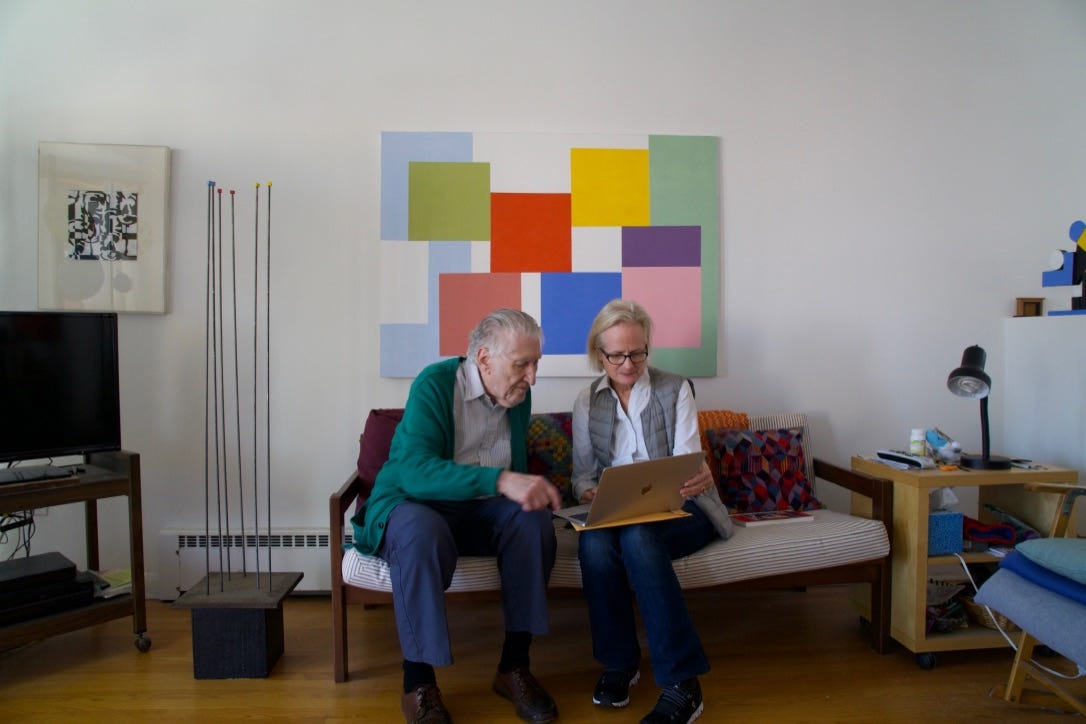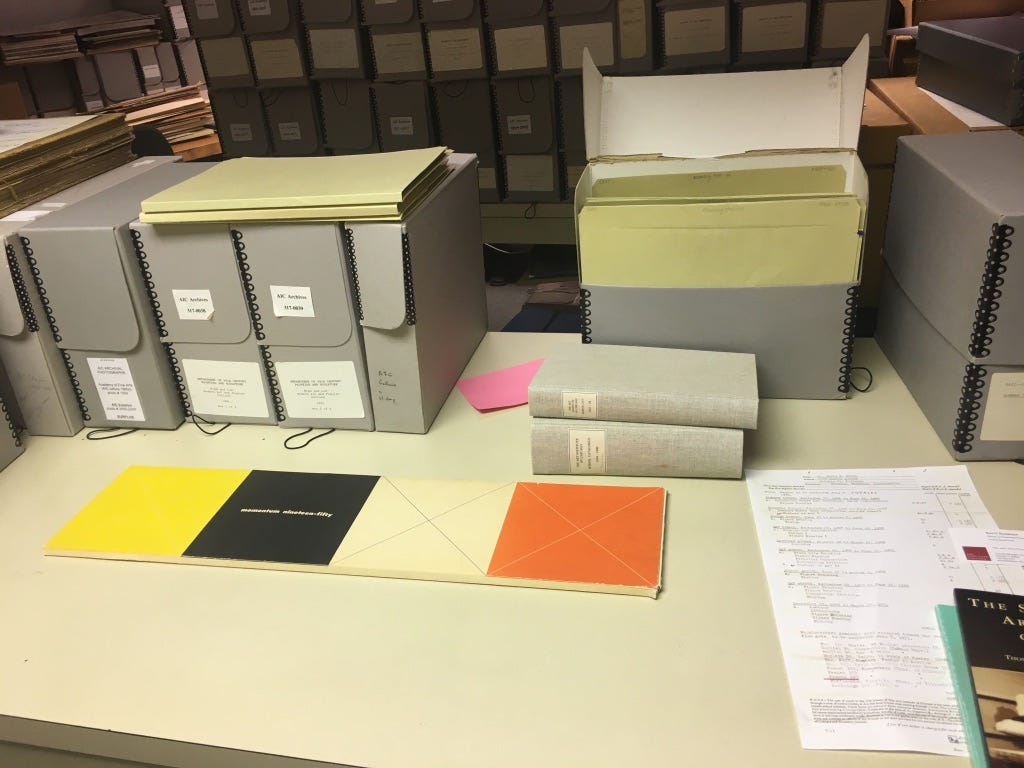
When I started trying to reconstruct my father’s art career I looked for papers, paintings, and people. I didn’t expect to find many people. My father didn’t stay in touch with his family or hold on to his friends, which I later speculated was because of the strain of keeping his sexual identity secret. But I lucked out in finding a few of his nonagenarian friends from art school still living. I met with two. I spoke on the phone with another. They have all since passed away.
When I planned a research trip to Chicago in 2019 I contacted my father’s alma mater, the School of the Art Institute of Chicago (SAIC), about their archive. The archivist told me there wasn’t much from the 1940s, but I was welcome to come in and he’d ask around about surviving alumni. He wrote a few days later, "Good news! I found a former SAIC student and teacher who remembers your father!”
That was how I ended up at Thomas Kapsalis’s home a few weeks later.
My husband and I drove north to Andersonville, once a neighborhood of Swedish immigrants, and picked up cardamon rolls at a Swedish bakery to bring to Tom and his wife, textile artist and teacher Stella Kapsalis. They had long since retired from teaching but still lived with their daughter, who was also an artist, surrounded by brightly-colored canvases and wall hangings. We spent hours in their House of Art, talking to Tom and Stella about their memories and their work. Tom pointed to a slim metal sculpture mounted on a wooden stand and described how he had made it in a German POW camp after being wounded in the Battle of the Bulge. He had collected sardine cans from the rations distributed by the Red Cross, cut them up with the tiny metal key, and braided the pieces into a hollow vessel he called a toothbrush holder. It even had a removable cap. He grinned as he told the story but his daughter later said she hadn’t heard it until a few years ago, when he broke his silence about his war-time experiences.
Like my father’s house, Tom’s home was littered with the stuff that caught his eye. For these artists everything they saw could be useful, and keeping random stuff around was inspirational and stimulating. In addition to overflowing bookshelves, Tom and Stella had two looms for her use in their basement and raw materials everywhere. Tom went to one wall and took down a Plexiglas box. It was filled with cut-out shapes and he gave it a good shake, like it was an Etch-a-Sketch. The pieces settled in new compositions. “See?” he told me, smiling. “Now it’s a new work.” Tom had spent his life devoted to geometric abstraction in two and three dimensions. “The figure was over,” he said.
Toward the end of our visit Tom asked me what my father’s work was like. “In the fifties he was an Abstract Expressionist, exhibiting collages and geometric paintings,” I said. “Then in the sixties he turned more toward Op Art with works on Plexiglas in fluorescent colors. But in the seventies he returned to the figure and made a series of representational portraits of people he saw in the city. Later, when he retired, he made a lot of poured abstract paintings and drew with colored markers on foam core….”
As I was talking I heard how this sounded: suddenly my dad seemed like a fad-follower, a chaser of trends, a copycat. Instead of leaning into non-objective abstraction, like Tom, or line illustrations, like Bob Parker, my father went through dramatically different phases. What did that mean? I wasn’t sure, which made me uneasy. He tried everything. That was good, right?
I meant to record our conversation but we walked around their house and I ended up with just photos and notes I wrote up later. By late afternoon our next stop was Oak Woods cemetery, where my grandparents were buried.
“Are you sure it’s open to the public?” Stella asked.
I was sure. I told them about visiting Northern Ireland with my mother and finding some cemeteries locked. So this time I had checked online. My husband and I drove off, talking nonstop about art and life as we followed Lake Shore Drive down to the South Side. It took an hour to cross the whole city from one end to the other. We drove past my father’s childhood home (I was too shy to knock on the door), past the Nation of Islam headquarters, and found the cemetery closed. It was five p.m. and it had closed at four thirty. I took a photograph of the locked gate and wondered what I would have found inside anyway.
I hadn’t learned anything specific about my father from Tom either. He reminisced about the teachers they shared in common, like Paul Weighardt or Kathleen Blackshear, but hadn’t known my father well. I asked him if he knew my father was gay and he shook his head. I wasn’t sure they were even friends as much as classmates. But the ambiance was invaluable— the sense of their generation, the ways to live with and make spaces for art. Tom had stayed in Chicago, stayed at SAIC. My father could have done that too, but didn’t— which led in small cross currents to me, to this here now. That trip brought me face to face with my family’s Chicago origins: I also met a second cousin I had never met before and found my father’s high school yearbook—the students so white, the boys so formal in their suits and ties!—at the Chicago Public Library.
In an ongoing project like this one, doors open and close. Tom passed away in 2022. I was so lucky to have met him, Stella, and their daughter, and to have visited their home. I should have written and shared this piece sooner, when he could have read it, but I was cautious. Even now, I worry about invading people’s privacy, sharing too much on the internet— even with the best of intentions. I deleted a photo of Stella in their art-filled basement and kept only the one of me and Tom as an introduction to the piece. I don’t want to neglect her contribution to that visit, though. My strongest memories were of the family’s overflowing creativity and generosity, of Stella’s warmth and Tom’s beatific smile.
Honestly, my father, whom I loved dearly, was not himself a model for that kind of generosity. He had limited interest in or attention for other people. I’d like my project to be different— to share freely, as much as possible, to believe in abundance (of gifts and talents) and plenty (of attention and recognition) for everyone. This, then, is something of a revision as well as a belated tribute.
Please share, like, or repost this piece if you enjoyed it. I look forward to any thoughts you may have in the comments. I’m so grateful for your presence in this community and your attention to these essays—
And keep scrolling for related posts:
- ’s Two Houses. Two Painters. Two Parents explores her childhood with divorced artist parents and her research into their art careers. Her father, Lennart Anderson, was another SAIC alumnus who knew my father later, when they both relocated to New York City. Her latest post mentions his retrospective, opening in Chicago on March 27th. I saw the show at its first stop in New York City years ago and highly recommend it.
I did eventually get inside the cemetery to visit the family grave. See The Family Plot.
I wrote about other SAIC friends of my father in Line of Vision and Winston. I also found my father’s name in SAIC teacher Kathleen Blackshear’s address book, digitized by the Archives of American Art at the Smithsonian. I interrupted this drafting to click through all its pages, parsing the names again for absences as well as presences. Tom and Stella Kapsalis are there too.




What a tender and touching piece of writing, Victoria. It's such a treat to join you on this journey to find out more about your father and the people and places that shaped his life.
To believe deeply in abundance and generosity of spirit. This is sticking with me.